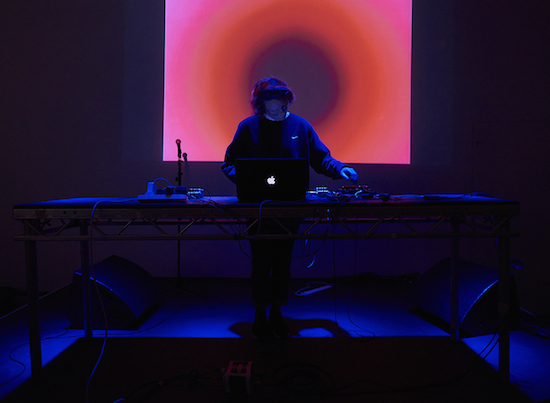Photo by Sylvain Deleu
Space, both as a notion and as a physical presence, is something that permeates this year’s Wysing Festival, which now in its seventh edition, bears the vastitude title Space-Time: The Multiverse. Inside the main gallery, the setup has been rotated so that the stage runs parallel to the audience, forcing you closer to the performers. Four mounted monitors emit some of the best sound I’ve ever heard from such a basic setup courtesy of sound engineer Charles Poulet, although as someone quite rightly points out later on, Poulet "could get good sound out of a bag of nettles". Over the course of the day, the idea of space plays out in myriad ways. Klara Lewis jars landscapes together via field recordings, bristling abrasive and ambient textures, while contemporary dancer Lucy Suggate, – who performs within a central rectangle taped off on the floor as James Holden plays cuts from his The Inheritors album – explores the physical margins of space within the gallery. Any permission to join in the dancing is denied by the delineated marker of white tape, and while Suggate’s choreography is mesmerising – she moves across the floor both frantically and deliberately; occupying corners; intensely staring into the middle distance – it’s also fascinatingly aggressive and constricting.
Beatrice Dillon’s late afternoon set falls 45 minutes behind schedule, so by the time it begins at quarter to five, the audience has swelled into the narrow space before the stage. Dillon, from beneath a projection of bleeding C-Type photogram visuals by artist Jesc Bunyard, pumps thunderous ascending drone through the room. There’s discordant whistling and the hiss of percussion before waves of bass roll in and out, leaving delicate moments of deliberation just before it kicks. The clicks of percussion steadily form patterns over reverbed wood block taps, before the familiarity of Dillon’s Blues Dances rings through the whips of noise. There’s a warmness here that’s not so tangible on record; the "oh oh oh" vocals are hinted at rather than fully deployed, so that they stretch out into sonic smoke rings that float above the crowd, rising until they break. ‘Longing’, the Ernst Jandl-sampling track from Blues Dances, emerges from depths, drums panning until the whole thing slows down entirely and the percussion is reduced to crackles. Here, Dillon propels it forward once more until it teeters on the edge of chaos, before slowing it again, ever-meandering, neatly avoiding the temptation to go for the upwards trajectory with a casual nudge of a finger on her laptop keyboard.
Towards the latter half of the set, Verity Susman emerges with a saxophone to play the wonky rhythms that pepper Dillon’s excellent recent Where To Now 12", Face A/B. The framework of ‘Face A’ emerges and settles, before slipping into something else. Later, when Jen Allan plays it in her excellent closing DJ set to a looser-limbed, more inebriated crowd over on the Amphis stage, it’s met with joyous high-energy dancing. Here though, before darkness, the kick drums are punctured and the otherworldly bloops brush against jackets and shoulders with little return. This juxtaposition of reactions seems to signify what I perhaps find most interesting about the music Dillon is making at the moment – its nebulous ambiguity; how it constantly teeters on the edge of definition, allowing itself to be malleable to any given context. As a concluding vocal sample fades out into silence, the gallery space is filled once more – with the loudest applause of the day.
<div class="fb-comments" data-href="http://thequietus.com/articles/18844-live-report-beatrice-dillon-review-wysing” data-width="550">


